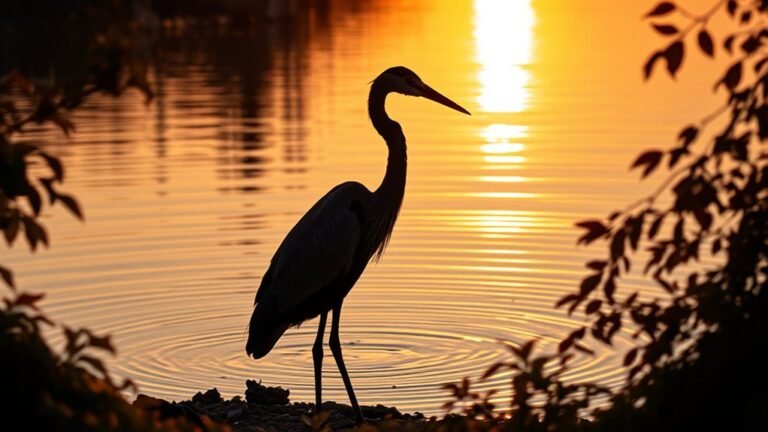11 Animals That Symbolize Death
When we think about animals that symbolize death, a few come to mind. Each animal has its own meaning.
Let's start with the raven. This bird is often seen as wise and mysterious. Many cultures believe ravens can see into the spirit world. Then there's the owl, which many people link to the unknown. Owls are quiet and watchful, making them seem connected to the dark and the hidden aspects of life.
These animals help us think about life and death. They remind us that life is fragile and that we should pay attention to what is around us.
Can you think of other animals that might also symbolize death? It's interesting to explore how different creatures share similar meanings in our lives and cultures.
Key Takeaways
- Ravens are known to be a sign of death and change. They make us think about the mysteries of life.
- Owls are seen as symbols of wisdom and the afterlife. Many cultures believe they protect the souls of the dead.
- Vultures help our planet by eating dead animals. They show us how death can lead to new life.
- Bats represent change. They are thought to guide souls as they move to the afterlife, showing us the unknown.
- Snakes are symbols of rebirth. When they shed their skin, it reminds us that new beginnings can come after death.
The Raven
The raven is a striking black bird that many people find mysterious. In different cultures, this bird means different things. Often, people think of ravens as signs of death, showing the change from life to what comes after. Their dark feathers and unique calls make them both interesting and a bit scary. This reflects how humans feel about life and death.
In many stories, the raven represents not just death but also wisdom, intelligence, and change. It encourages us to think about things we don't understand.
The raven can make us feel both fascinated and uneasy, reminding us of the thin line between being alive and what lies beyond. By thinking about these ideas, we can better understand our own life and experiences.
The Owl
Owls are often seen as wise animals, and they carry a sense of mystery in many cultures. People often think of owls when they talk about death and the afterlife. For example, in ancient Egypt, owls were like protectors of the dead. Some Native American groups believed that owls could signal when someone close to you might be leaving this world.
Owls are special hunters. They can see well in the dark and hear sounds that are very soft. This makes them seem even more mysterious. When you see an owl, it might make you feel a shiver or a connection to something bigger than yourself.
Owls remind us that life and death are connected. This can help us feel a part of the big cycle of life. They show us that wisdom and the end of life go hand in hand, making us think about our place in the world.
The Black Cat
Black cats are interesting animals with many meanings across different cultures. People often have strong feelings about them. Some see them as good luck while others think they bring bad luck.
Here are four popular beliefs about black cats:
- Good Luck: In some places, seeing a black cat is a sign of good fortune and happiness.
- Witch Companions: A long time ago, people believed that black cats were pets of witches, which made them seem mysterious.
- Bad Signs: Some think that if a black cat crosses your path, it means something bad might happen, like sickness or misfortune.
- New Beginnings: Others believe black cats can represent change, showing that good things are coming.
These different stories show how we feel about black cats. Some love them for their charm, while others fear them because of old tales.
No matter the beliefs, black cats continue to capture our imagination.
The Moth
Moths mightn't be the first insects you think of when talking about death.
Still, they often show up in stories and myths with a darker meaning. These creatures fly at night and are usually linked with changes between life and death. Moths carry mystery and transformation.
Different cultures see moths as messengers between the living and those who've passed away.
They're attracted to light, just like we search for answers in the dark. When you watch how they fly, you might feel a sense of how quickly life can pass by. Moths remind us of our own time on Earth.
In this way, moths symbolize the shortness of life.
They connect us to the cycle of living and remind us that we all eventually return to the shadows.
The Vulture
Vultures mightn't be the most loved birds, but they're really important for nature. These birds help clean up the environment by eating dead animals. This helps keep our surroundings healthy and stops diseases from spreading.
In different cultures, vultures have special meanings:
- Nature's Cleaners: Vultures recycle nutrients. They show us that life can continue even after death.
- Symbols of Change: Some people see them as signs of transformation and new beginnings.
- Guides for Souls: Many cultures believe vultures help souls find their way after death.
- Signs of a Healthy Ecosystem: When you see vultures, it often means the environment is doing well.
Understanding how essential vultures are can change the way you think about these unique birds. They remind us how everything in nature is connected.
The Snake
The snake is a powerful symbol in many cultures. It often represents death, but there's more to it than just that. Snakes move quietly and can bite with venom, which can scare people. However, they also show change. Snakes shed their skin, and this process reminds us of rebirth.
This change doesn't happen without death. In many stories, snakes help guide souls from life to the afterlife. They remind us that endings can bring new beginnings.
Snakes are often seen in funerals, reinforcing their link to death and what comes after. Their mysterious nature encourages us to think about life and death together, showing us that both are part of our journey.
The Spider
Spiders mightn't be the first thing that comes to mind when you think about death. However, their webs and hunting ways can carry important meanings. Spiders create webs, which can symbolize how life can become tangled. Just like they catch their food in their webs, this can remind us how fragile life is.
In many cultures, spiders are seen as symbols of both making and ending things. Here are some simple ideas to think about:
- Cycle of Life: Spiders go through many changes in their lives, showing how we can be born again and grow.
- Fate: Some cultures think of spiders as tying together life and death, showing how both are connected.
- Isolation: Spiders often work alone, which can represent the loneliness that comes with death.
- Mystery: Spiders make us wonder about what happens after we die and the unknown things we might face.
The Bat
Bats are interesting creatures that make people think about death in many cultures. In stories and legends, bats often represent change and the afterlife. Different societies see bats as symbols of the unknown. They can bring feelings of fear about death and the dark.
Many traditions view bats as guides that help souls go to where they need to be in the afterlife. When you see a bat, it can remind you of life and death. This can help you think about what happens after we pass away.
There are many types of bats, like the spooky vampire bat and the friendly fruit bat. Each type has its own meaning, but they all remind us of important life lessons.
Learning about bat mythology can help you understand more about life and death and how we're all connected. This creates a sense of belonging and shows that we all share similar experiences.
The Scorpion
Scorpions are fascinating creatures that many people find interesting. They've a special role in different stories and cultures, especially when it comes to death and what happens after.
Here are some important ideas about what scorpions symbolize:
- Protectors of the Dead: In many stories, scorpions help protect those who've passed away and guide their spirits.
- Change and Rebirth: Scorpions often stand for the change from life to death. They can show us the idea of starting anew.
- Fear and Respect: Their sting can hurt, which makes people afraid of them. This fear reminds us to respect life and the idea of dying.
- Connection to Immortality: Many tales link scorpions to living forever. They connect the world of the living to the spirit world.
Learning about what scorpions represent can help you understand different beliefs about life, death, and what might come after.
The Horse
The horse is an important symbol in many cultures. People often link horses to death and what comes after life. In stories and myths, horses guide souls to the next place. They're strong and graceful, which adds to their meaning in these stories.
In Greek myths, horses pull Hades' chariot. This shows how they help souls move from life to death.
In Norse traditions, horses play a big part in burial ceremonies, helping guide the dead on their last journey.
The Fox
The Fox
Horses often symbolize guidance in death, but the fox tells a different story. It has its own unique meanings linked to the afterlife in many cultures. The fox is clever and crafty, showing both life and death.
Here are some important points about fox symbolism:
- Trickster: The fox is a trickster. It can move between the living and the dead.
- Smart: The fox is known for its sharp mind, which helps it solve problems and understand life.
- Flexible: The fox can adapt and survive. This highlights how life goes in cycles.
- Protector: The fox can guard souls, helping them on their journeys.
These meanings make the fox a strong symbol that connects us to the mysteries of life and death.
Frequently Asked Questions
What Cultures View These Animals as Symbols of Death?
Many cultures view different animals as symbols of death. For example, ravens often represent bad luck or omens in many places. Certain reptiles, like snakes, can symbolize change and renewal. This shows how people link animals to ideas about life and death in their own unique ways. Each culture has its own stories and meanings that make these symbols special.
Are There Positive Associations With These Animals?
Many animals linked to death also represent life and change. They make us think about new beginnings and how life goes on. These animals can help us feel connected to each other and understand that we all share similar feelings. They encourage us to reflect on the cycles of life, reminding us that endings can lead to new starts. This can bring comfort and a sense of community.
How Do These Animals Affect Popular Culture?
Movies and books often show animals in ways that shape how we think about them. Sometimes, these portrayals can make us feel scared, and other times they make us curious. They tap into feelings we all share, like fear or wonder. This connection helps us understand stories better and can change how we feel about these animals.
Can These Animals Be Omens of Good Fortune?
Some animals that people think bring bad news can actually mean good luck in different cultures. This shows how our views shape what we believe. It helps us connect with the mysteries of life.
For example, in some places, seeing a specific bird or bug can signal that good things are coming. It's interesting to see how animals can have different meanings. They remind us that life is full of surprises. Keep an open mind, and you might just find joy in these signs!
What Is the History Behind These Symbols?
Symbols hold different meanings in different cultures. People use them to show beliefs, stories, and values. Looking at their histories helps us see why these symbols matter to people over time. By understanding these connections, we can appreciate the special meanings behind the symbols we see in our everyday life.
Exploring why a symbol is important can be exciting. It helps us connect with others and learn about their cultures. When we know the story behind a symbol, we can find joy and understanding in how it shapes our world.

Hi, I’m Ethan—a spiritual wordsmith at SpiritualDivineInsight.com. My passion lies in exploring the mysteries of spirituality and sharing transformative insights. Through my articles, I invite you on a journey of self-discovery and mindfulness. Join me as we navigate the path to enlightenment together.








